"The Kwakiutl artist painting on a hide did not concern himself with the inconsequentials that made up the opulent social rivalries of the Northwest Coast Indian scene, nor did he, in the name of a higher purity, renounce the living world for the meaningless materialism of design. The abstract shape he used, his entire plastic language, was directed by a ritualistic will towards metaphysical understanding. The everyday realities he left to the toymakers; the pleasant play of non-objective pattern to the women basket weavers. To him a shape was a living thing, a vehicle for an abstract thought-complex, a carrier of the awesome feelings he felt before the terror of the unknowable."
-Barnett Newman , The Ideographic Picture 1947
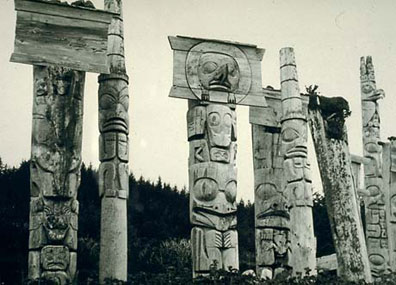
Haida Totems Queen Charlotte Island 1890's
It has been sixty years since Newman's Ideographic Picture was the introduction for a show at the Betty Parson's Gallery in New York. I have always found this essay to mark not only the turning point. For me it sums up a series of ideas that were in the air before the artists like Newman, Rothko and Pollock reached their mature styles. It was the calm before the storm and was written as the artists were about to discover themselves. In 1947 neither Newman nor Rothko had discovered the language of their painting that would make them famous. Pollock had moved to the Springs a year earlier and in the summer of 1947 he would begin to experiment with his drip paintings. De Kooning was still working in black and white and his paintings of women were still three years away. Although it was a time in which most of the artists that would define the terms of twentieth century art were still finding their voices. It is worth noting that Still had already been producing paintings in his mature style since 1945.
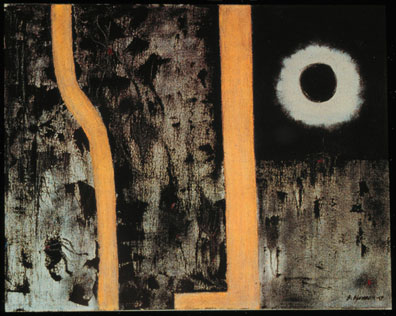
Barnett Newman, Death of Euclid 1947
One example of Newman's painting in 1947 is Death of Euclid. The painting is still full of ideas about what he thinks painting should be about. The surface is scumbled with a black paint on a white ground. The picture is a populated with strange and interesting shapes like the "L" shape that occupies the center of the picture and the "Black Sun" shape in the upper right hand corner. The shapes still do not integrate themselves with the picture plane of the canvas and they read as figures floating above the scrubbed ground. The shapes are formalist because they do not give the viewer any traction to be able to interact with them. The painting is closed. He was trying to use a formal strategy to create a representation of the experience he wanted to communicate. He might have been thinking that if the shapes were abstract and formal enough, then perhaps he could induce the sort of experience that he was seeing in the Totem poles of the Kwakiutl artists.
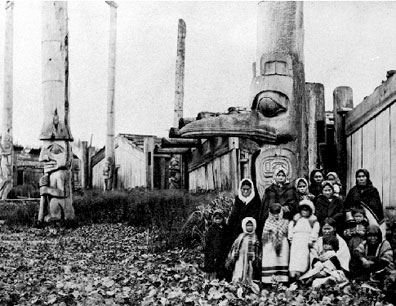
Haida Village Queen Charlotte Island 1890's
If the totems were mistakenly seen to be formal, Newman probably felt that the best way to create a similar response in his own work would be to have a formal solution as well. Newman was not the first artist to be looking at tribal art to influence or inspire his own work. Gauguin had moved to Tahiti (twice) to get to a state of mind that would allow his work to have the same power and directness as the work that he would find in flea markets in Paris. Twenty years later Picasso and Matisse were browsing the same flea markets looking for inspirations or parallels to their own work. In the thirties, the Surrealists that frequented Peggy Guggenheim's gallery Art of this Century, especially Max Ernst, began using tribal art as objects in their own paintings. It is interesting that in each case, with the possible exception of Picasso, tribal art was always treated as a formal object that could be depicted or represented. An object, like objectivity, is by definition different or outside of yourself.
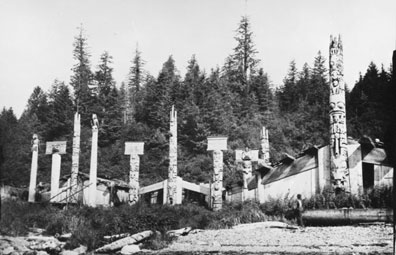
Haida Village Queen Charlotte Island 1890's
I suppose this seems a little more relevant to me because I was in Vancouver, Canada over the weekend. You can see work by members of the First Nation on practically every street corner. A few days later I was able to spend some time in Royal British Columbia Museum in Victoria on Vancouver Island. I was impressed that when the carvers make the totems, they are not really depicting anything. Every image rather man, animal, or supernatural creature is already a part of their ancestry. Everything was real, alive and already a part of them. They have a direct, personal, experiential connection to every image that is made for a totem, nothing is "abstract". To reinforce the personal, experiential connection to these images, some were worn as a mask where the member of the tribe becomes the embodiment of that particular animal or spirit. It would stand to reason that members of a tribe would be able to wear different masks at different stages of their life, which would create a direct, personal connection with a variety of animals. Their experience with the totems was entirely subjective. The totems were a means to end and not a formal object. It is also important to realize that most tribes saw themselves as integrally a part of nature and the environment in which they lived.
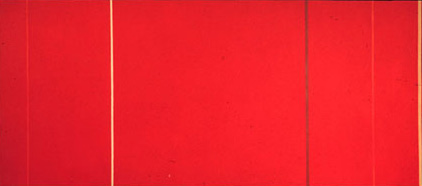
Barnett Newman, Vir Heroicus Sublimis
An interesting side note is that before the second half of the twentieth century, most Western artists still treated a painting as a rectangular window in which you are looking out on to something else. In this scenario, you are always separate from what you are depicting. There is an invisible barrier between the viewer and the subject. We live under the illusion that there might be an objective experience, even though it is always filtered through subjective experience. Even the uncertainty principle in quantum mechanics precludes a purely objective point of view. We inevitably change what we see. It is my understanding the most tribes of the First Nations, their experience is entirely subjective. There is nothing more than what you are and have experienced. This is why I think that Death of Euclid is a formal painting, while Vir Heroicus Sublimis is not. Any painting in which there are elements that are dominant enough to create a figure/ ground relationship is a formal painting. The separation of figure and ground parallels the separation between the object and the subject.
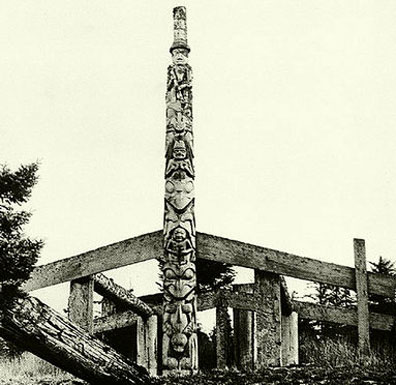
Kayung pole Haida Gwaii 1884
I think that when Newman wrote The Ideographic Picture he hit upon the idea that difference between most western art and tribal art is the difference between the objective and subjective epxeriences. In 1947, he is trying to use objective means to create a subjective experience. Newman was not alone in thinking along these lines. In the early forties, Rothko was also working along the same lines with his water colors based on the Greek tragedies and Pollock with his supernatural creatures in his paintings of the early to mid forties. It was only after these artist's matured, they found ways to use subjective means to convey or allow for a subjective experience. They were working on a way to have to the subject of the painting be inseparable from the experience of the painting.
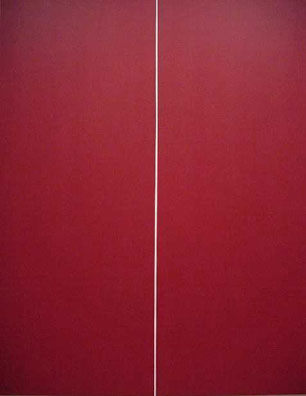
Barnett Newman, Be I (Second Version) 1970
Before 1947, the paintings of Newman, Pollock and Rothko are very exciting and full of ideas. Every canvas is filled with ideas of what a great paint should be about. The paintings are full of ideas, expectations, and desires. The problem was that the more they added, the further they got away from the subjective experience they were trying to convey. In their mature styles, there is radical simplification of form, process and materials. Newman paints narrow zips in a field of color, Rothko paints floating rectangles of color, and Pollock drips the paint. I believe that they are literally taking themselves out of the painting to make room for the viewer to have their own subjective experience. Forms were helpful when they were used as the means, rather than the end. Forms, like the totems, became vessels of experience. In this way I would consider the Northwest Mystics formalist painters but not, perhaps counter intuitively, artists like Donald Judd and Agnes Martin. Both Martin and Judd used formal elements (the horizontal lines, rectangular boxes) to create an experience that led back to the awareness of the viewer. As Newman, Rothko and Pollock began to find their mature style, I wonder if they thought it was strange that the solution to integrating convey subjective experience was not formal and objective but experiential and subjective. The experience was already there (theirs?), they just had to get out of the way.
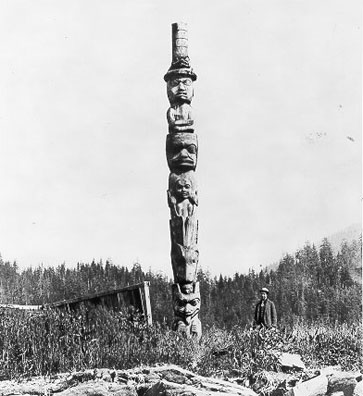
Tlingit Village, Fort Wrangell Alaska 1899
"The Americans evoke their world of emotion and fantasy by a kind of personal writing without the props of any known shape. This is a metaphysical act. With the European abstract painters we are led into their spiritual world though already known images. This is a transcendental act. To put it philosophically, the European is concerned with the transcendence of objects while the American is concerned with the reality of the transcendental experience."
-Newman's reply to Clement Greenberg's review in The Nation, December 6, 1947, quoted in Thomas B. Hess, Barnett Newman, New York, 1969 (the original reply was not published in The Nation)
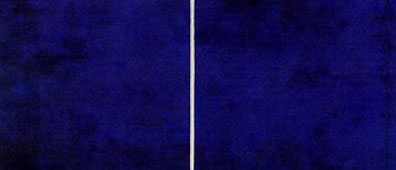
Barnett Newman, Cathedra 1951


























